A complete guide to Makalu Base Camp Trek
Mountains radiate an incredible aura. The remote mountain display is an impeccable art that shapes life and is a reconciliation of a peaceful journey.
Mountains radiate an incredible aura. The remote mountain display is an impeccable art that shapes life and is a reconciliation of a peaceful journey.
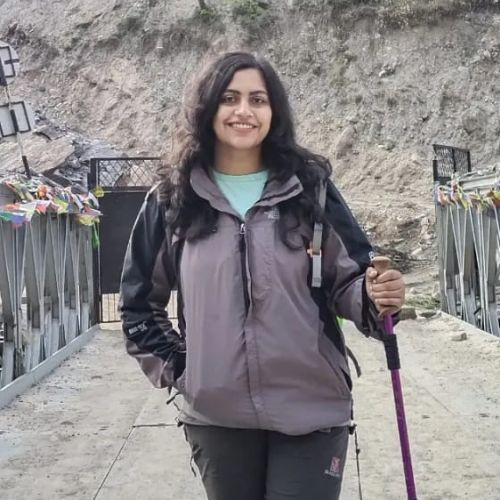
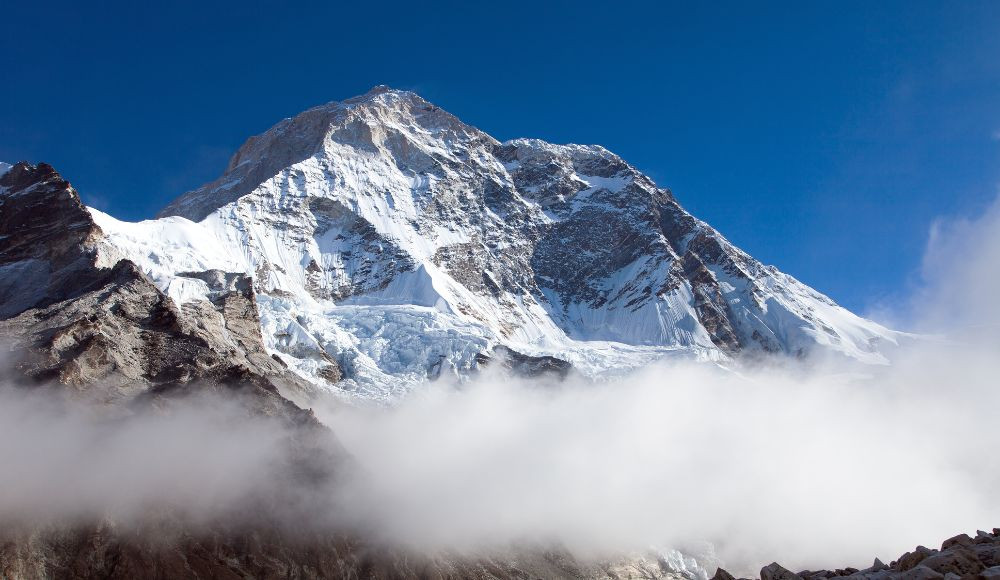
The magnificent journey to Makalu base camp trek has long been one of Nepal's finest trekking phenomena.
The Makalu base camp trek is a wonderful journey for nature lovers looking to see some of the world's tallest mountains, including Everest, as well as distinct perspectives on them. The mountain Makalu (8,481m above sea level) is the fifth highest in the world, yet its base camp is a less-travelled path because of its distance. It isn't overly difficult to get there, as there are daily flights from Kathmandu and rudimentary lodges along the route.
The Makalu base camp trek is a wonderful trek for outdoor enthusiasts who wish to explore the inaccessible regions of Nepal and learn about the country's culture and way of life. The isolated areas of the Himalayan country, as well as the Himalayan nation and culture and way of life of those who live at higher elevations, will be explored on this trek. This trek is ideal for adventurous trekkers seeking for peace and quiet in the Himalayas.
It has been off-limits to the outside world until the 1950s when Eric Shipton first visited the region and it became known to a few intrepid hikers; as they journeyed through, camping along the way.
You'll find yourself in the Barun Valley, which is about as deep into the mountains as you can go. Past the Barun River Valley, you'll encounter steep granite cliffs, glaciers, and magnificent waterfalls which are otherworldly. The Sherpa people, an ethnically Tibetan people who live primarily near Everest at higher elevations live here.
The trek begins in Rai-populated, terraced farming land, which is home to the Rai people, an ethnic group that mostly dwells in Nepal's eastern hills. The most beautiful moments of the trek are in the Rhododendron Forest where you can find 25 species of Rhododendrons and Cloud Forest, which you will pass through as the route ascends (most magnificent in the spring, when the wildflowers bloom brilliant red, purple, pink, and white).
You'll also go through some of Nepal's last untouched forests recognized for their tremendous diversity in plants and alpine meadows. You may also encounter some of the exclusive wild animals such as the Snow leopard (Heung Chituwa), Himalayan Black Bear, Clouded Leopard, and Red Panda which are also listed as endangered species.
The trek to the foot of the world's fifth-highest peak passes through Makalu Barun National Park, which is renowned for its natural splendour and wide range of plant and animal species. This trek is not just about checking out the stunning scenery and wide range of flora and fauna. It also offers a lot of variety, as well as contrast, with daily bringing a broad choice of picturesque rewards from 700m to 5,000m in elevation.
The rarely seen Kangshung face of Everest, as well as Lhotse, Chamlang, and Kanchanjunga in the far east, are all visible from Base Camp on Mount Makalu. The Makalu Barun National Park is Nepal's eighth-largest park, covering 2,330 square kilometres, and it is home to some of the country's rarest plants and animals.
The locals of the region include many different cultural and ethnic backgrounds, languages, and customs. The majority of the population is made up of Rai, Shingsawa (Bhote), and Sherpas, who have their own rituals and traditions. The journey to experience Nepal's far-flung way of life is a naturally beautiful and culturally instructive excursion.
The ultimate approach to base camp is unquestionably one of the most spectacular walk-ins in the world, with Mount Makalu's awe-inspiring, massive presence dominating when you arrive at base camp.
The region is home to some of the world's most beautiful scenery, which may be experienced at Makalu Barun National Park. This trek also takes you to areas you've never been before. Because of its remoteness, this area provides visitors with a unique opportunity to discover and interact with tiny but charming communities that are hidden from the rest.
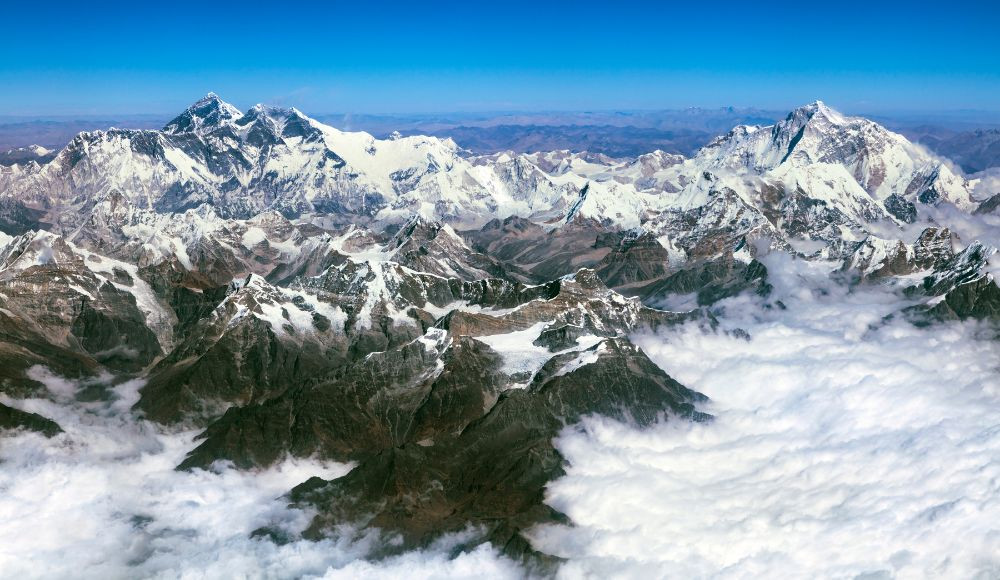
The remoteness of the location makes it all the more appealing. From a vantage point above the basecamp, you get an excellent panorama of several of the world's highest mountains, including Everest (8,848m), Lhotse (8,516m), Chamlong (7,319 m ), and Baruntse (7129m).
The trekking route to Makalu base camp visits both magnificent and spectacular features, which will leave you amazed. It also gives you a new experience as you journey toward base camp, putting you right in the middle of all the natural beauty.
The trekkers have the opportunity to see the lovely Tibetan and Sherpa villages in the peaceful Himalayas. The trekkers will also walk along Arun Valley, which is one of the remotest regions of Nepal. As a result, they will be informed about the difficulties faced by people who reside in these sorts of locations.
The views on both ends of the journey are magnificent, and you get the major benefit of having a second chance to see your vistas if they were obscured by clouds on your departure. In reality, this trek has everything you need to make it a truly exceptional and exciting experience; towering 8000 peaks, breathtaking vistas, magnificent settings, an interesting objective, and exquisite seclusion.
Moreover, the Makalu base camp trek is one of the most enthralling treks that you should visit and reminisce about for your lifetime.
|
Trail Name |
Makalu Base Camp Trek |
|
Country |
Nepal |
|
Area |
Barun Valley |
|
National Park |
Makalu - Barun National Park and Conservation Area |
|
Established Year |
1992 |
|
Trek Difficulty |
Strenuous |
|
Trek Starting Point |
Num Village |
|
Trek Ending Point |
Num Village |
|
Best time to visit |
|
|
Major Mountains |
|
|
Passes |
|
|
Required Permits |
|
The incredible Makalu base camp trek is in Sankhuwasabha, Nepal's eastern region, and is entirely inside Makalu Barun national park (Jewel of eastern Nepal). It follows the banks of the Arun and Barun rivers, lush forests, alpine meadows, deep valleys, and towering passes. The Makalu base camp trekking is located in the Makalu – Barun National Park and Conservation Area, which was established in 1992 as Nepal's eighth national park and the first to include an adjacent inhabited conservation area as a buffer as well as a protected area.
The Makalu base camp trek is an adventurous trek through eastern Nepal's most spectacular province. The trip will take you to Makalu Barun national park and Makalu Conservation Area, where you can see numerous plants and animal species, including rare species. The Makalu region is a restricted area, and trekking there requires permission from the Nepalese government. You will walk through five major zones as you trek across the "Makalu base camp trek," including the beautiful Arun Valley, dense woods of rhododendron and fir, and alpine meadows.
Tumlingtar is the starting point of the Makalu base camp trek, which begins in the mid-eastern sector. This is a high-altitude trek that visits lower landscapes of lush rhododendron forests, picturesque Gurung villages, river valleys, and the Makalu Barun national park. At more significant elevations, the barn is visible from a distance, surrounded by towering Himalayan vistas, deep high-altitude lakes, and passes to traverse to reach the camp.
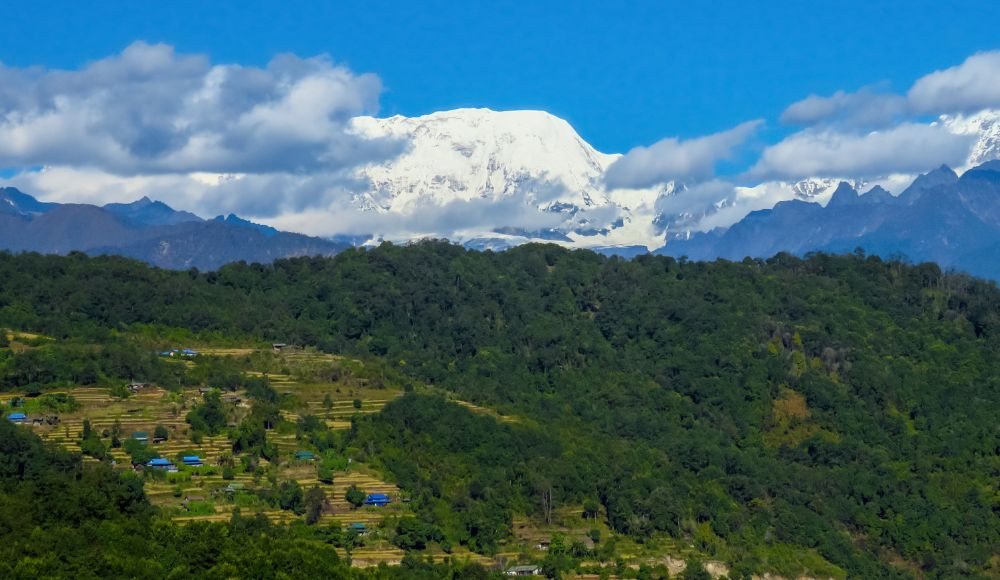
Due to its remoteness and the fact that base camp is a unique experience, the region sees few foreign trekkers. There are several species of orchids (About 47 types ) and more than 3,000 kinds of flowering plants in the woods. The region is home to a wide range of wildlife, including the endangered red panda, musk deer, Himalayan tahr, and leopard. There are over 400 species of birds in the park, some of which are quite uncommon.
The Wren is a tiny songbird that has a distinctive loud call. It's also been reported that the uncommon Wren-Babbler resides in this area.
Makalu base camp is located in the peaceful and unspoiled Makalu Barun national park in eastern Nepal's Makalu Range. As a result, the Makalu trekking routes are home to a variety of unique ecosystems. Furthermore, in terms of topography, no other area in the world boasts such diversity.
The peaceful and unspoiled eastern half of Nepal's Makalu Barun National Park is home to Mount Everest, the world's tallest peak. As a consequence, trekking routes in Makalu are full of unique ecosystems. Furthermore, the terrain is unique in any other location on Earth.
The Makalu Barun National Park is one of the most biodiverse areas on Earth, with 3,000 species of flowering plants, 440 types of birds, and 75 mammal species including the snow leopard, red panda, musk deer, wild board, wild yak, and Himalayan Thar.
Makalu base camp trek is one of the diverse, authentic places and is one of the least visited teahouses in Nepal. Even though there are comparatively a less number of trekkers trekking throughout the Makalu base camp, it is one of the best-hidden trekking secrets. Makalu base camp trek is flourished with enchanting views of nature where you will be attracted towards and will be able to take out one of the best experiences of your lifetime. Also, due to the remoteness of the area, the natural beauty has always been preserved to its fullest and the trekkers will get to explore the untouched beauty in the Makalu base camp trek.
Throughout your journey to the Makalu base camp trek, you will encounter different attractions and beautiful places which will be reminisced in your heart for a lifetime. Some of the major attractions around the Makalu base camp trek are as follows:
Arun Valley, the deepest valley in Nepal, is one of the least altered and yet one of the most unspoiled trekking routes in Nepal. Arun Valley is cradled by a variety of natural marvels and indigenous culture. Arun valley is one of the deepest valleys situated in between Sagarmatha National Park and Barun National Park in the Eastern Part of Nepal. Arun valley is mostly known for its untouched beauty which is a sanctuary to 650 species of birds, 800 species of butterflies, vegetation, animals such as orchids, and rare and endangered animal Panda.
It is located in Nepal’s Makalu region, which is adjacent to the Everest District of Nepal. The Arun River, which runs through the valley, gives it its name. The lovely and peaceful pathways through the Rai and Sherpa settlements of Arun Valley Trek become more beautiful and endearing as a result of the presence of these great Himalayas.
The Arun Valley, one of the intriguing locations in Nepal, is better recognized for its culture as well as natural beauty. The Arun Valley is a wonderful and picturesque site where you can observe birds in addition to taking in the beautiful scenery. Similarly, from the Arun Valley, you may enjoy the breathtaking views of the Kanchenjunga and Makalu mountains.
Shiva Dhara is one of Nepal's sacred pilgrimage sites, located inside the Makalu Barun National Park. Shiva Dhara is one of Lord Shiva's most holy fountains, situated near the dome-like cave that measures 500 feet in length. On a full moon day, hundreds of pilgrims trek to this tap to bathe, but to get to this place one has to climb an extremely dangerous cliff for 2-3 hours with mindful precautions as the trail is very risky and tricky.
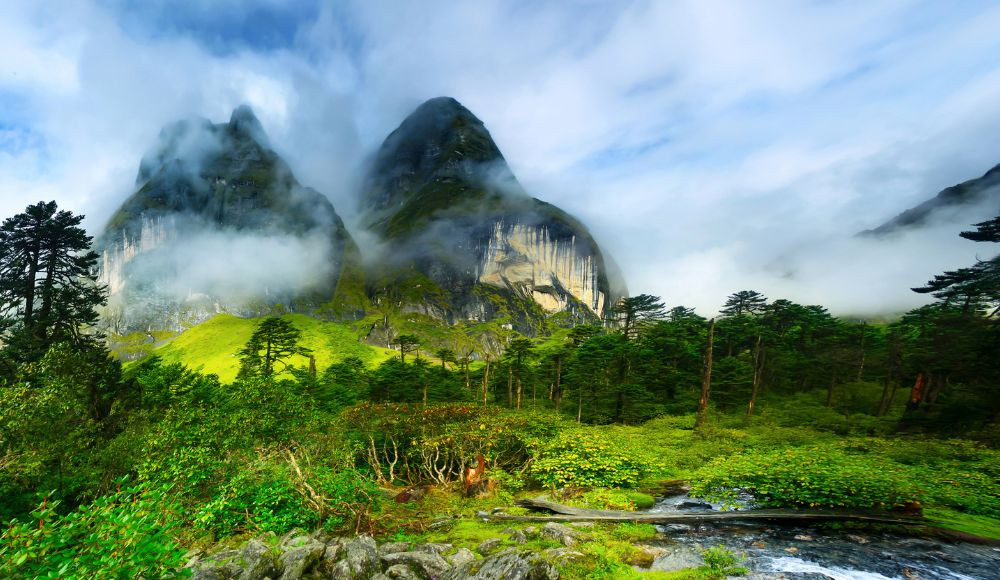
Shiva Dhara is a beautiful and holy sight, which you will be astounded by as you approach it.
Also, it is said that the person who bathes in this holy waterfall will be free of all illnesses. Shiva Dhara is said to have been the bathing place of Lord Shiva and Parvati in ancient times. However, it has now grown into a sacred religious site that is almost continuously snow-covered throughout the year.
Moreover, you should visit the beautiful and holy Shiva Dhara, one of Nepal's holiest pilgrimage sites, while exploring the Makalu base camp which is one of the major attractions in the Makalu base camp trek.
The Barun Valley is one of the most beautiful locations in the Himalayas, with a gorgeous backdrop of snow-capped mountains. Barun Valley is a stunning valley nestled beneath Makalu Mountain's slope.
Besides the stunning vistas of the tall mountain ranges, Barun Valley also has striking contrasts, with cascading waterfalls plunging deep gorges. The Makalu Barun national park in Nepal encompasses Barun valley. As a result, you may see various and unique species of flora and fauna.
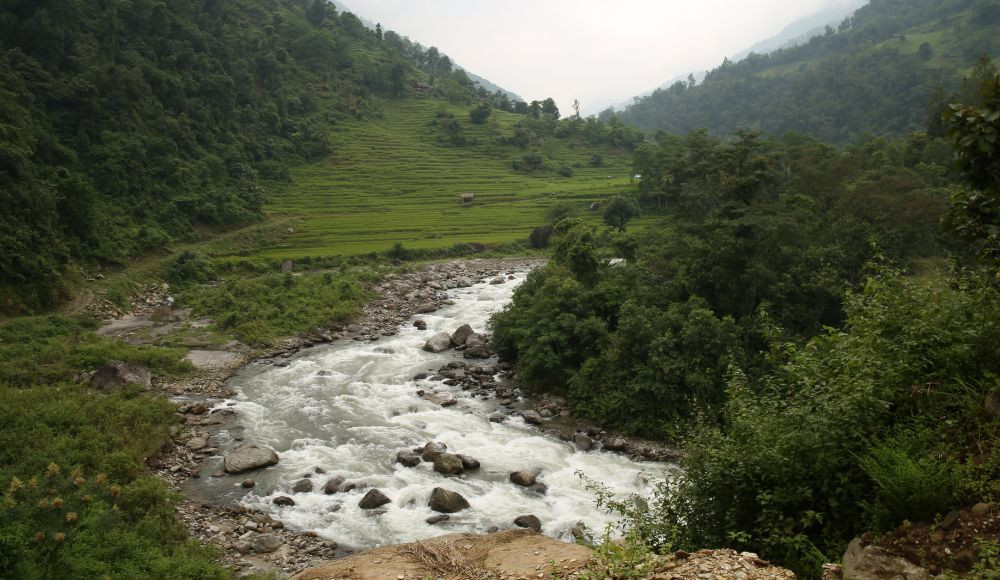
Barun Valley is also a paradise for bird watchers, as it contains about 440 species of birds. Barun Valley is one of Nepal's least visited areas. We may notice fascinating rock formations, beautiful waterfalls, and lush vegetation.
Besides the scenery and diverse biodiversity, it has its own religious values. Hindus and Buddhists consider this place as a holy place, Hindus consider this place as a sacred tap of Lord Shiva which is called Shiva Dhara and Buddhist scripture describes this place as a mysterious evergreen place where no one gets old.
In a nutshell, If you are planning to explore this place, you can expect amazing waterfalls, untouched wild nature, exclusive wildlife, beautiful landscapes, and more. Hence if you are searching for a peaceful and beautiful destination away from the concrete jungle, Barun Valley is the one.
Barun Pokhari is a lake located at an elevation of 5,250 meters above sea level in the Makalu Barun National Park of Nepal. It is one of the highest altitude lakes in Nepal's Makalu Barun National Park. Similarly, it is also ranked among the world's highest altitude lakes.
Take just a few minutes of walking from the South Makalu base camp to reach the Barun Pokhari. Above all, it is located beneath Makalu and offers stunning views of the mountain ranges. In addition, during the winter season, the lake is frozen and you will get to witness the spectacular view of the frozen lake.
Makalu Barun national and buffer zone is a national park in the Himalayas of Nepal which was established in 1992 A D as eastern extension of Sagarmatha national park. It covers an area of 1,500 km² (580 sq mi) in the Solukhumbu and Sankhuwasabha. It is located in the eastern climatic zone of the Himalayas.
The monsoon starts in April due to the extreme difference in altitude in the entire area. The skyline is a panorama of uneven mountain peaks including Mt. Chamlang (7,319m), Mt. Baruntse (7,129m), and Mera Peak (6,654m). There are many lakes and spectacular waterfalls which are formed on Mt. Everest, which is the major attraction in Makalu Barun National Park.
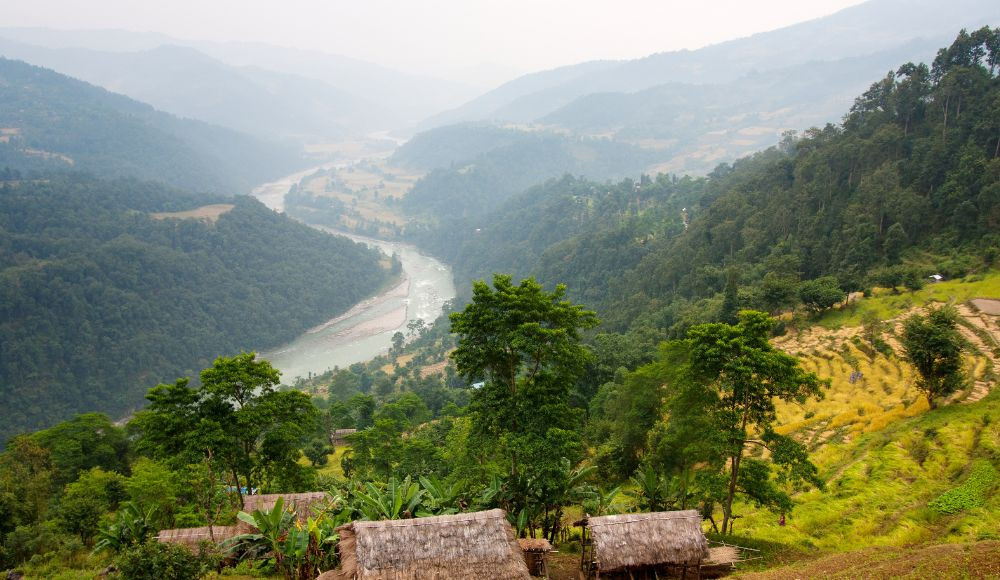
Makalu Barun National Park is well known for its wide range of flora and fauna such as different types of wild orchids, varieties of Rhododendrons, and different species of wildflowers which cover the hills in its season with beautiful vibrant colors such as purple, yellow, dark pink, yellow, white and so on.
We can also find some of the aromatics and medicinal herbs there which are hard to find in other parts of the country. Not only herbs and wildflowers, we might encounter some of the exclusive animals here in their natural habitat such as Snow Leopard, Clouded Leopard, Red Panda, (listed as endangered animals), Black Himalayan Bear, etc.
We can also get the opportunity to observe the isolated and minimalistic lifestyle of Rais, Shingsawa (Bhote), and Tibetan groups who predominantly reside near Everest.
Dudh Pokhari, also known as Kunda, is a milky lake that sits at an elevation of 4,600 meters above sea level within the Makalu Barun National Park in Nepal. This holy lake, Dudh Pokhari, is located in the Solukhumbu district of Nepal. This magnificent milky lake is one of Nepal's less-travelled and yet beautiful destinations.
It is also located on the base of Numbur Himal. You should also explore Dudh Pokhari which will be a beautiful sight for the sore eyes while exploring the Makalu base camp trek.
|
Day 1 |
Arrival at Kathmandu |
|
Day 2 |
Kathmandu Sightseeing and Trek Preparation |
|
Day 3 |
Fly to Tumlingtar and drive to Num |
|
Day 4 |
Trek to Seduwa |
|
Day 5 |
Trek to Tashi Gaun |
|
Day 6 |
Trek to Kongma Dada |
|
Day 7 |
Trek to Dobato |
|
Day 8 |
Trek to Yangle Kharka |
|
Day 9 |
Trek to Langmale Kharka |
|
Day 10 |
Trek to Makalu Base Camp |
|
Day 11 |
Makalu Base Camp Exploration |
|
Day 12 |
Trek to Yangle Kharka |
|
Day 13 |
Trek to Dobato |
|
Day 14 |
Trek to Num |
|
Day 15 |
Drive to Tumlingtar and Fly to Kathmandu |
|
Day 16 |
Departure |
Following is the detailed itinerary of the Makalu Base Camp trek where you will get the detailed information about the places you are going to observe, the places you are going to stay and the activities you are going to do throughout your exciting trekking journey.
By the time you've arrived at the Tribhuvan International Airport, our office representative will meet you at the airport and lead you to your hotel, where you may unwind for a while before continuing with your journey. In the meanwhile, our office representative will walk you through all of your activities on the itinerary.
Meals: Not included.
Elevation: 1350m
On this day, you can simply stroll around Kathmandu and see some of the UNESCO World Heritage sites in the valley. The nearest destinations that are frequently advised are Swayambhunath Stupa, Pashupatinath Temple, Boudha Stupa, Kathmandu Durbar Square, Bhaktapur Durbar Square, etc.
In Kathmandu, sightseeing will be a pleasant pastime for you. You may also do some shopping and souvenir collecting while you're in Kathmandu, as well as obtain a Makalu Barun National Park trekking authorization.
You could also have the option of watching and enjoying the nightlife of Kathmandu, as well as getting ready for your trek.
Meals: Breakfast included
Elevation:1350m
Take the road or fly to Tumlingtar. You may reach Tumlingtar by taking a domestic flight from Tribhuvan International Airport that takes 30 minutes. After arriving at Tumlingtar airport, you may drive to Num.
It will take around 6 hours to get there by car. Then we reach Tumlingtar where we can enjoy a stunning view of the Nepalese countryside's mountains, hills, and rivers.
Meals: Breakfast, Lunch, and Dinner.
Elevation:1560 m
At 07:00 AM: We will have to make several ascents and descents as we travel along the Barun River. We must first cross the river, then climb to the opposite bank. The terrain is challenging, and the climate may be hot because of the amount of activity and lower-altitude land here.
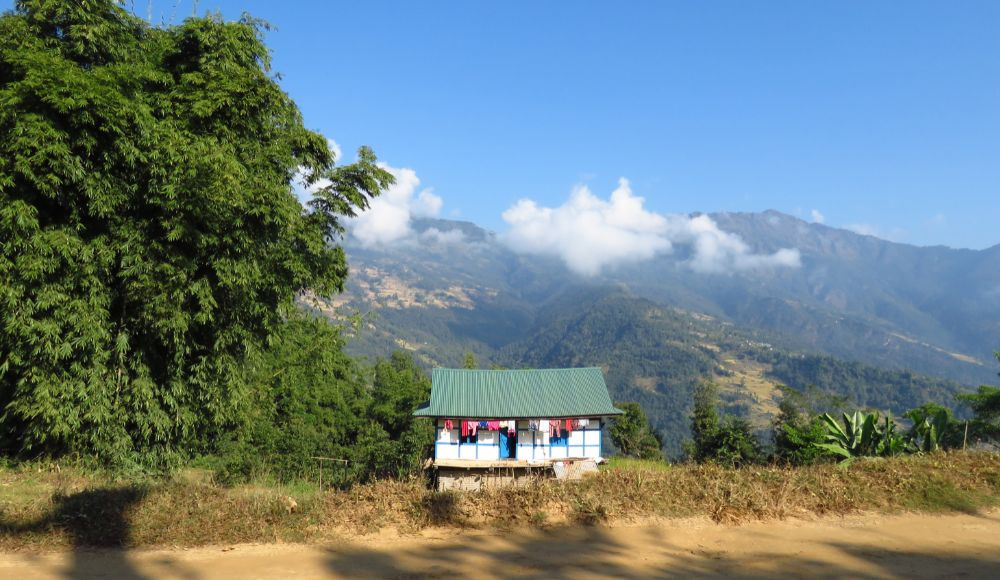
You'll mostly walk beneath the canopy of trees. Makalu Barun National Park begins here, and permits must be obtained. We continue along the rocky path and tiny terraced farms of corn and barley, gradually ascending to Seduwa.
Meal: Breakfast, Lunch, and Dinner included
Elevation:1500m
At 07:00 AM: You will walk through meadows and farms up to Tasi Gaun. Enjoy the trip more slowly by taking in the scenery. Before reaching Tashi Gaun, you will pass through several inhabited areas as well as rivers.
You will have a chance to see the spectacular vistas of the mountain ranges. The trekking route passes through rural regions on both sides, which will welcome you. Then you'll get to Tashi Gaun, a lovely village.
Meals: Breakfast, Lunch, and Dinner included
Elevation:2100m.
At 07:00 AM: This will be a difficult day on a steep pathway with an elevation of over 1400 meters. We'll climb through forests to a stream and then onto a ridge, where there is a tiny shepherd's shelter. The path then goes down gradually to the valley floor, eventually reaching a kharka and culminating at the ridge's peak. From there, it is a short journey to Khongma.
Meals: Breakfast, Lunch, and Dinner included
Elevation: 3500m.
At 07:00 AM: Reach the top of the Shipton La pass, which may take several hours to climb. Keke La is 4,170 meters high after Kalo Pokhari has passed over Keke La at 4,170m.
The views of Chamlang, Peak 6, and Peak 7 are breathtaking. You'll travel through the lovely valley down to Dobato after crossing the Keke La pass.
Dobato is at 4,170 meters above sea level in the beautiful valley.
Meals: Breakfast, Lunch, and Dinner included
Elevation: 4170m.
At 07:00 AM: The Barun River and the upper reaches of the valley are reached after passing through the rhododendron forest. The first two hours of your journey may be hazardous as the path is steep and difficult. You might see yaks grazing in a pasture on your way.
We then go for a nice stroll, gradually rising in elevation until you reach Yangle Kharka, which is located at the bottom of the valley and has an elevation of 3,557 meters above sea level.
Meals: Breakfast, Lunch, and Dinner included
Elevation: 3557m
At 07:00 AM: After we've crossed the Barun River Bridge, we can see a large prayer wall before trekking into the valley. We'll have a slow stroll to the valley, passing through yak pasturelands and dark forests.
After a two to three-hour walk, the vegetation becomes sparser. We can see magnificent views of the Himalayas from here. Take a stroll through a jungle and across breathtaking cliffs on the other side for spectacular scenery. Spectacular views of the surrounding mountains will soothe your mind. You'll cross several kharkas before reaching today's destination, Langmale Kharka.
Meals: Breakfast, Lunch, and Dinner included
Elevation: 4410m
At 07:00 AM: The exploration day has come. This is the day we'll be trekking to the Makalu base camp, where we'll have a chance to view the fifth tallest mountain in the world.
From Langmale Kharka, we depart for Shershong and ultimately Makalu base camp. The trail is smooth, with icy glaciers and snow-capped mountains on either side. As we approach Shershong, Mt. Makalu comes into view. We get to enjoy the magnificent Himalayan scenery as we trek to our destination. We have the opportunity to soak up the stunning Himalayan vista around us.
You will notice the rich variety of flora and fauna that abound in Makalu's base camp, which is home to many species of plants and animals. The prominent Makalu peak at the base camp.
Meals: Breakfast, Lunch, and Dinner included
Elevation:5250 m
At 07:00 AM: Today, we will go for a walk to see the magnificent Makalu base camp. The camp is located on beautiful ground, so we are frequently treated with a stunning view.
If you want to combine excitement and adventure, a day excursion to the ridge with spectacular panoramic mountain views is an exciting option. There are fantastic views of Mount Everest, including the north face and Lhotse Shar. From this vantage point, you can see northeast to Lhotse, Lhotse Shar, and Everest, all of which offer stunning vistas. We may also visit the region's lakes, and glaciers, and photograph them while taking advantage of the remaining time.
Meals: Breakfast, Lunch, and Dinner included
Elevation:5250 m.
At 07:00 AM: We head to the corner and retrace our steps back down. We will once again go through Shershong & Langmale Kharka on our way down, as well as end our trek for the day in Yangle Kharka.
Meals: Breakfast, Lunch, and Dinner included
Elevation: 4170 m
At 07:00 AM: You will walk along the Barun River from Yangle Kharka. Further pass through alpine forests, rocky ridges, and a few little streams before arriving at Dobato via the free-flowing Barun river. Snow pigeons, yaks, and deer may be seen on our way.
Meals: Breakfast, Lunch, and Dinner included
Elevation:4170 m.
At 07:00 AM: You will leave Dobate, Kongma Danda, Tashi Gaun, Seduwa and trek through dense forests to the remote region of Num, which is located at an altitude of 1,560 meters above sea level.
Meals: Breakfast, Lunch, and Dinner included
Elevation:2580 m.
At 07:00 AM: Today you will drive back from Num village to Tumlingtar and pave our way back to Kathmandu. After reaching Kathmandu, you can rest, relax and enjoy your time here.
Meals: Breakfast, Lunch, and Dinner included
Elevation:1350 m.
You'll fly back home from here. The flight will depart from Tribhuvan International Airport. You must arrive at the airport three hours before your flight's departure time.
Meals: Breakfast included.
The total cost of the Makalu base camp trek is 1995 USD. This total cost comprises of different factors. Within this cost, different variables are involved which include:
The cost excludes
Get in touch with our experts right away and finalize an experience!
About UsThe best months to visit the Makalu base camp trek is from March through May and September through November. The weather during this period is consistent, and the trekker can fully appreciate each wonderful journey aspect. The temperature will be pleasant, as well, and the spectacular sights of Mount Everest (8848 m), Lhotse (8516m), Makalu (8463m), Chamlang (7319m), and Baruntse (7129m) can all be seen.
The Makalu base camp trek is most popular between September and November, with March through May being the optimum months. However, this journey isn't advisable because of the deep snow on the Makalu base camp in early March.
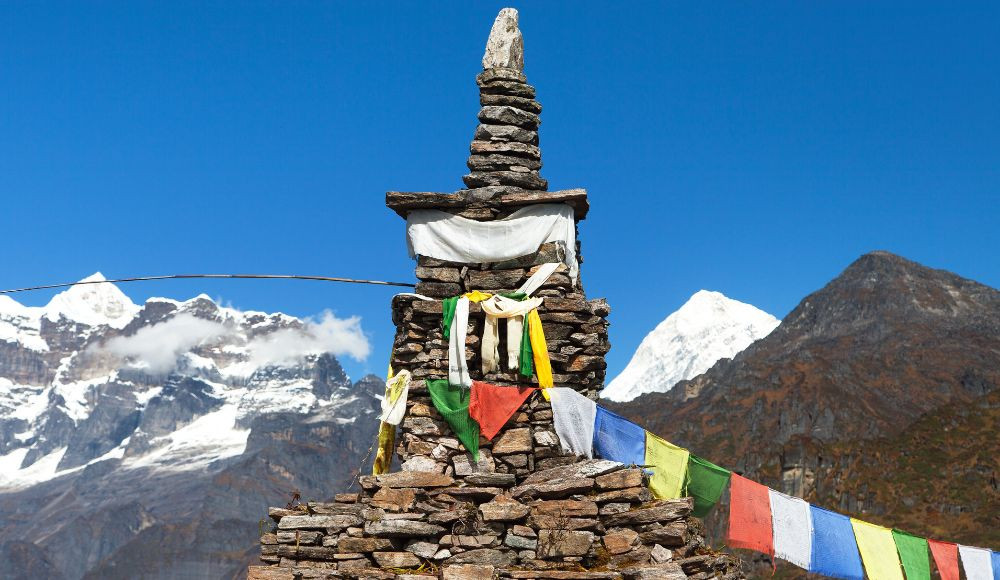
The best times to visit Makalu base camp are during the spring and fall trekking seasons when the weather is most likely to be good (particularly at low and mid-elevations). It is possible to undertake this walk in the winter, but the cold temperatures may be a deterrent, especially because none of the lodges in this area is not so well–equipped.
Spring is the peak season for trekking, mountaineering, or any sort of adventurous activities that you are trying to engage in. This time of year's weather is ideal. You can see the mountain all the way too far away. The alpine forest is a rainbow of blooms, with rhododendron and magnolia among them. During this period, the weather in Nepal's southern regions is somewhat humid, but it is still quite chilly in the Himalayas. This is known as Nepal's trekking season when conditions are ideal.
The Spring Season is one of the finest seasons and times of year to go on a high-altitude journey. Nepal's spring season begins in early March and lasts until May. These months provide you with the greatest mountaineering and trekking adventure possible. During the spring season, the sky is usually clear. This season also offers a vast selection of exotic flora and animals for you to see. You not only get the greatest weather and temperature for your journey, but you also get to see beautiful and magnificent plants and animals during your trip.
You get to see the finest views of the mountains and landscapes when the weather is clear. The magnificent peaks may be seen from the trails, which are dotted with tiny hamlets. Everything, from little villages built underground to exquisite glaciers created, can be seen clearly with your eyes during this season, enchanting you throughout it. So this is one of the most admired seasons to explore the beautiful Makalu base camp trek.
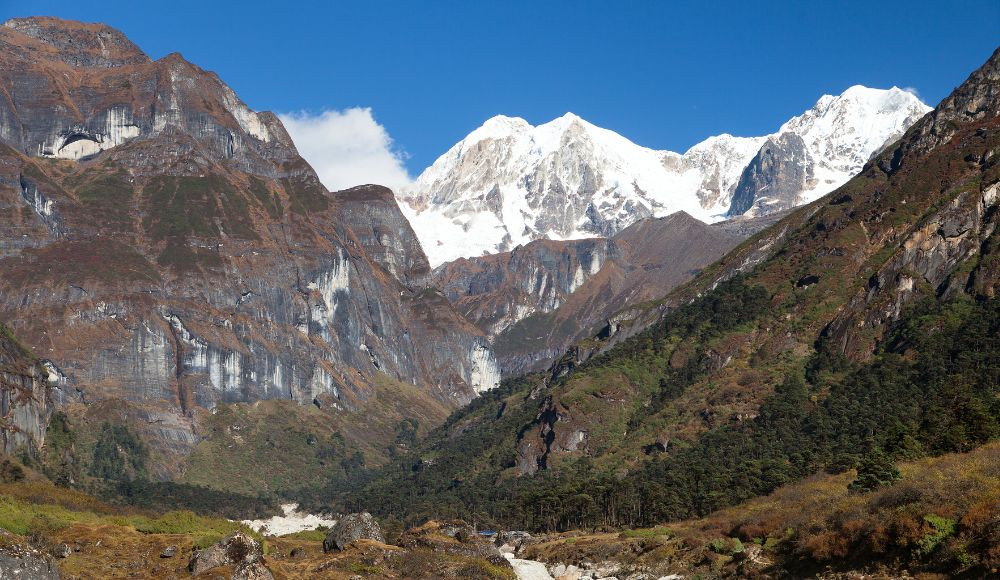
Spring is the second greatest peak season for the Makalu base camp trek. Springtime sees snowfall at great altitudes, owing to the mild and sunny weather. On high passes, you're likely to encounter snow and ice since it's cold. The magnificent scenery is not only seen in the fall but also through the spring. During this time, while most of the mountainside is still covered in bloom, greenery and a rainbow of colours adorn the surroundings along with different flowers and magnificent sceneries.
It is another gorgeous season ideal for daring Makalu base camp trekking. The best time for Makalu base camp trekking is from mid-September to Late-November when autumn is in full swing.
The weather during the fall is typically clear skies with no intense sunshine drying you out on your journey. The temperature, too, is comfortable, allowing you to go without freezing or being scorched by the sun.
Another important reason for the Makalu base camp trek being best in Autumn is that it is during this time of year when there are many religious events. Apart from having gorgeous skies providing a more magical and memorable trip, most of Nepal's major gatherings take place in this season. Experience these customs and distinct cultures, and your trek will be far more memorable. At this time of the year, the mountain views are at their finest which will give a thrilling and magnificent experience to the trekkers.
For a reason, the best time to trek in Makalu base camp is during the autumn. With little rain, the sky is clear. Daytime temperatures are comfortable and bright. The nights will not be as chilly as they would in other seasons. However, during nights at comparable altitudes, the temperature may fall below freezing point.
‘A flat trail never made a skilled trekker’. In order to reach the Makalu base camp, patience and perseverance are one of the most needed attributes that a trekker should have because the Makalu base camp trek is not an easy trek to conquer. It is a strenuous trek due to the remoteness of the area as it falls under one of the most untouched and remote regions in Nepal.
The Makalu base camp trek is steeped in difficulty. However, you shouldn't worry about yourself so much since walking at a constant speed and being patient will most certainly aid you in completing this journey and discovering the stunning Makalu base camp. There are several challenges while trekking to this beautiful Makalu base camp. The following are some of the difficulties you will encounter and should be taken care of while ascending the Makalu base camp:
The problem of altitude sickness is one of the most frequent afflictions that trekkers experience when they travel to higher altitudes. It's a condition or issue caused by decreased air pressure, which makes it hard for trekkers to handle the lower air pressure and the greater elevation.
Although many people are familiar with the risk of altitude sickness, it can affect anyone. Someone may get a minor or mild form of altitude sickness, while others may have trouble climbing up due to the greater proximity of altitude sickness.
Many trekkers on the Makalu base camp trek will suffer from altitude sickness since they must climb very high up to higher elevations. Many trekkers will not be able to reach the top of Makalu base camp as a result of this sickness.
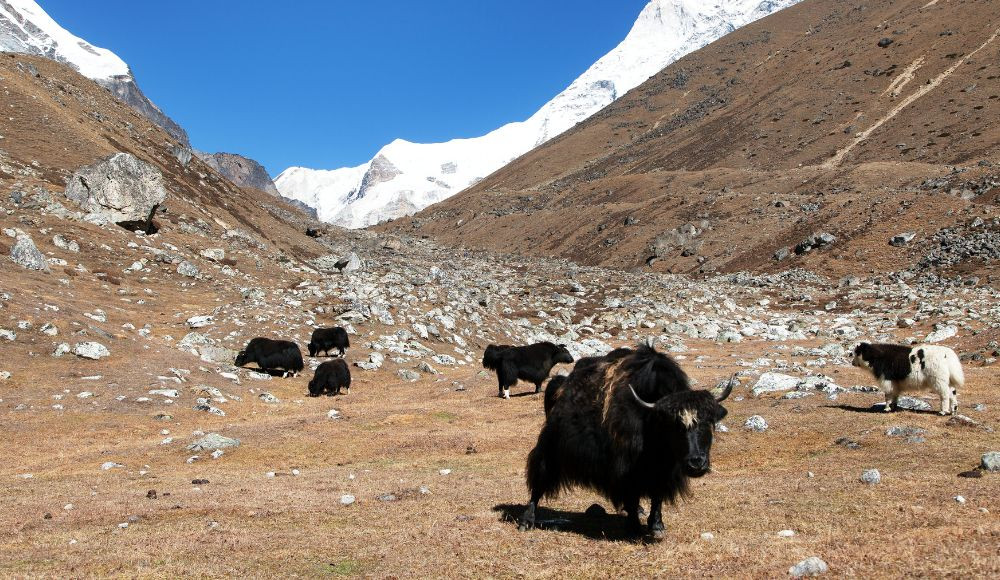
To prevent or alleviate this problem, the itinerary should be designed in such a way that a large amount of elevation isn't covered at once and the trek is done slowly and steadily with adequate acclimatization. To successfully scale the Makalu base camp, it is important to remember to take precautions against altitude sickness.
If these circumstances worsen, HAPE (High Altitude Pulmonary Edema) and HACE (High Altitude Cerebral Edema) occur.
HAPE is the condition in which there is the excess accumulation of fluid in the lungs.
HACE is the condition in which there is excess accumulation of fluid in the brain.
Hence, in order to avoid these extreme conditions, proper acclimatization should be done and medicines should be taken with proper prescriptions such as Acetazolamide and Dexamethasone.
The symptoms of altitude sickness are
The Makalu base camp trek is located in one of Nepal's untouched and isolated areas, the Makalu region. Luxury services are not accessible on the same level as on the Everest base camp trek, Annapurna Circuit treks, and other trekking routes.
This trek’s expectation should be reduced to a bare minimum, with only the most basic facilities available, such as teahouse lodging and simple meal preparation.
In the Makalu region, extreme weather may make trekking more difficult. Follow the guide's instructions carefully, and if you are walking without a guide, you must be more careful on the path and take necessary precautions when unexpected weather conditions arise.
The climate may be extremely harsh and unpredictable during the winter months (December through February). The winds are typically strong. As a result, protection is necessary while ascending toward the Makalu base camp since serious events can occur as a result of difficult and changing weather conditions in the area. As such, it's advisable to visit the Makalu base camp throughout the Autumn and Spring season.
The trekking difficulties of the Makalu base camp are next in line. Because the Makalu base camp trek is a tough trek and considerably more difficult than the Annapurna and Everest base camp treks, it might add to the difficulty for novices.
Beginners with little physical strength and perseverance may find it difficult to climb the Makalu base camp trek at once.
There may be various challenges on the trek, including extreme weather conditions, acclimatization difficulties during the journey, and others. As a result, appropriate precautions must be taken and implemented throughout the trek of the marvelous Makalu base camp.
Before coming on the trek, you must consider insurance, which is one of the vital factors to keep in mind. It's because if there are any issues with the trek, such as severe altitude sickness or unexpected health difficulties, insurance will cover it for you. If you haven't gotten insurance, extra costs will come into play, making things more difficult.
Related Article: Makalu Base Camp Trek Difficulty
You must acquire permits to visit the Makalu base camp. The Makalu Barun conservation area of Nepal constitutes the Makalu base camp. This zone requires a fee to enter.
The climbers must also pay for the TIMS (Trekkers' Information Management System) card, which is used to gather information about them and their destination. The main goal of the TIMS card is to obtain basic information about the trekkers and their intended destinations.
During times of emergencies or natural catastrophes, having these documents and fees can assist the trekkers to obtain the required resources or services. These are the permits and entrance fees you'll need to visit the Makalu base camp trek.
These are the prices of the required permits:
|
Makalu Barun Conservation Area Permit |
USD 30 per person. |
|
Trekkers’ Information Management System |
USD 20 per person. |
One of the most essential things to remember while packing for your journey is to pack light. Efficiency in packing should be achieved by considering a variety of factors, including where we are going, when we are traveling there, and how long we will be gone. These factors have a significant role in determining our packing list, especially for a trekking expedition.
The Makalu base camp trek is a trek in one of the most remote locations in Nepal. It is not as well-known as the Annapurna or Everest owing to its isolation.
The trek to Makalu base camp is a tough one that needs patience and perseverance to complete. This trek will take you to the magnificent Makalu base camp as well as mind-boggling locations around it, so be prepared! Due to the fewer trekkers going there, there is less of a crowd and with all of the required supplies and a little bit of diligence, this excursion may be completed successfully.
As a result, make a packing list by attempting to limit the number of clothes you bring. You should attempt to keep your clothing as light as possible in order to make a packing list. Because if the backpack is heavy, it will be difficult to climb up while on the trek, unnecessary and luxurious articles must be avoided. The trekking shoes must also be very pleasant and comfortable to wear since the long journey to reach the magnificent Makalu base camp will take a significant amount of time.
Please be informed that the services on the Makalu base camp trek will be limited, and you will not receive any extras. However, you will get basic accommodation with simple meals - mainly on a sharing basis - as well as basic amenities such as a simple room. If you want to bring some snacks and light chocolate bars for energy during the trek, then you can bring them and have them throughout your trek.
You don’t need to carry tents as tea houses are available but you can carry sleeping bags as your preference.
If you're looking for a comprehensive trekking gear checklist, the Nepal Trekking Gear Checklist is where to go.
The magnificent base camp trek is located in Sankhuwasabha, Nepal's eastern region, and takes place entirely within Makalu Barun National Park.
Makalu base camp trek is a very strenuous trek, hence requires a high level of determination and perseverance, also Makalu base camp falls under one of the remotest regions of Nepal, and only limited services are available. Hence, if you are well-determined and have got required physical strength, you can complete the trek. Also, acclimatization also plays a major role in accomplishing the trek.
It might be difficult for a beginner to complete this trek as this trek falls under strenuous grade and requires some previous trekking experience to complete this trek.
Makalu conservation area permit (MCAP) and Trekkers’ Information Management System (TIMS) Card are the permits required in order to do this trek as Makalu Base Camp Trek falls under the Makalu - Barun national park and conservation area.
Makalu base camp trek is a trek filled with a plethora of adventures and thrills. It takes you to the lap of the Himalayas and you will witness the beautiful floras and faunas along with the untouched beauty of nature as the Makalu region is one of the remotest regions of Nepal. You will get simple and limited services, but you will not regret this trek because of the wonders and surprises it brings throughout the trek.
The best time to do Makalu base camp Trek is the Autumn season (Sept - Nov) and Spring season (Mar-May).
The highest elevation in Makalu Base Camp Trek is 5,300m.
We get teahouse accommodation in Makalu Base Camp trek.
It casually depends upon your pace of walking. But the average approximate hours of walking ranger 6-8 hours per day.
As Makalu Base Camp trek falls above the altitude of 4000m, there are high chances of altitude sickness. Hence, it is advised to acclimatize yourself properly and if needed, take medicines in order to avoid or reduce the altitude sickness, otherwise more serious cases such as HAPE and HACE might occur.
HAPE can be defined as the accumulation of fluid in the lungs.
HACE can be defined as the accumulation of fluid in the brain.
No, there are no such age restrictions to do the Makalu base camp trek. Being a difficult trek, it is not highly recommended. But, even if you want to accomplish the trek with children, then you can arrange an additional porter for that in case if they cannot walk any further due to different difficulties.
Mostly, acetazolamide and dexamethasone are the prescriptions in order to reduce and avoid altitude sickness.
The duration of the Makalu base camp trek is 16 days. But, you can modify it according to your preference.
Yes, of course, you can. Makalu base camp trek lies within the Makalu-Barun national park and conservation area which is home to about 400 species of birds and you can observe those exotic birds and hear their beautiful chirping around the way.
Makalu base camp trek offers you with numerous beauties of untouched nature ranging from alpine meadows to lush forests to incredible vistas of the Himalayas. Also, it is home to numerous exotic floras and faunas. All these factors make the Makalu base camp trek one of the beautiful moments to be cherished for your lifetime.